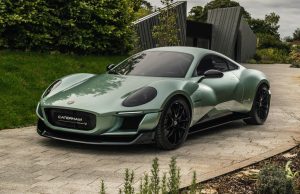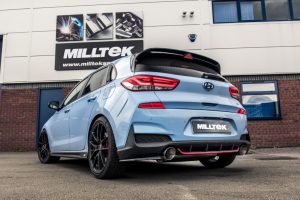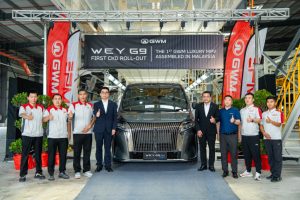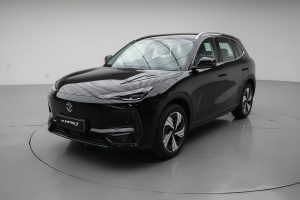THE all-new Mazda BT-50 is one more example of how pick-up trucks are increasingly becoming car-like.
Hot on the heels of the refreshed Isuzu D-Max 3.0 X-Terrain, which is what the BT-50 3.0 High Plus is essentially based on, the Mazda version of this top-seller in Thailand attempts to make a difference by leveraging on its Kodo design language on the exterior and some minor tweaks elsewhere.

For the uninitiated, the D-Max and BT-50 sold here share the same platform, with both fully manufactured in Thailand, though Isuzu model has risen to be king there, outselling even the venerable Toyota Hilux by a significant margin.
Looks-wise, the BT-50 is handsome, with its confident, planted stance projecting a solid expression of the Kodo “Soul of Motion” design language, though arguably, there is more room to creatively express it in passenger cars.

The new two-tone alloy 18-inch wheel design fits in well in the overall scheme, and when matched with the bi-LED headlamps, the good look is complete.
Driving experience is a highly-pleasing one, with the 3.0-litre turbodiesel effortlessly propelling the two-tonne truck to highway speeds in a jiffy, minus any huffing or puffing or lag.

In the Isuzu, the new engine, codenamed 4JJ3-TCX, produces 190PS and 450Nm of torque, up by 13PS and 70Nm respectively, over the older 3.0-litre block.
In the BT-50, Mazda engineers chose to reduce its output by a whisker, tuning it to 188PS at 3,600rpm, with the torque remaining unchanged.

However, this difference is more on paper, as it does not make any discernible difference in real world driving.
Interestingly, the BT-50 weighs in at 2,010kg, 15kg lighter than the D-Max.

From my quick observation, the omission of the sliding cargo bed tray - a useful feature for those who move a fair bit of things in the rear - by Mazda could have partly contributed to it.
Slowing the BT-50 down is no problem at all, with the disc-drum combo more than adequate for the job.

Cabin insulation is very good, with barely audible noises intruding at cruising speeds, so you get the full audio enjoyment from the eight-speaker sound system, or have conversations without needing raise your voice.
Fuel efficiency, if judged by the fuel gauge alone, is excellent for a vehicle of this tonnage, with the indicator hardly dropping even as I tried driving a bit more aggressively than normal to get a good feel of its engine and transmission.

Rapid lane changes also does not unnerve the BT-50, with its revised suspension geometry handling the job well.
In the cabin, the switches are sufficiently large and instinctive, with rear air-conditioner vents for those seated in the rear, befitting its proposition as a flagship pick-up truck.
And next to the rear air-conditioner vents is a USB port, proving that it is now extremely difficult to tell whether one is in a car or truck, if one just views the interior pictures alone.

Driving in darkness is also easy, thanks to the bright bi-LED headlights.
Other pluses include things like lane departure warning (can be turned off), blind spot monitor, as well as Android Auto and Apple CarPlay that are linked to a nine-inch touchscreen.
The 3.0 High Plus AT, being the top-of-the-range variant from Bermaz Motor, costs RM143,218 (private registration, on-the-road without insurance) or about RM800 more than the D-Max 3.0 X-Terrain.
Warranty is five years or 100,000km compared to the D-Max’s seven years with unlimited mileage.
For those looking for something a bit more wallet-friendly, Bermaz Motor also offers the 1.9-litre version (twin cab, automatic only) at RM124,179.
SPECIFICATIONS
Mazda BT-50 3.0 High Plus AT
Engine: 2,999cc, inline 4-cylinder, 16 valves, VGS turbodiesel intercooler, DOHC
Maximum power: 188PS at 3,600rpm
Maximum torque: 450Nm from 1,600 to 2,600rpm
Transmission: Six-speed automatic with sequential shift and selectable 4WD system with rear differential lock
Steering: Rack and pinion hydraulic-power steering system
Fuel tank: 76 litres
Kerb weight: 2,010kg
Suspension: Front independent double wishbones, with coil springs; rear semi-elliptical leaf springs
Rear bed: Bedliner, lashing points
Features: Seven airbags shared between driver and front passenger, traction control, electronic stability programme, hill start assist, hill descent control, automatic high-beam activation, automatic wipers with variable intermittent mode, front and rear fog lamps, 18-inch alloy wheels, automatic power-adjustable external mirrors with integrated LED turn signals, front and rear parking sensors, advanced driver assist system which includes forward collision warning, autonomous emergency braking, lane departure warning, adaptive cruise control, and seat belt reminder for all seats
Warranty: Five-year or 100,000km, whichever comes first
Price: RM143,218 (private registration, on-the-road without insurance)
















